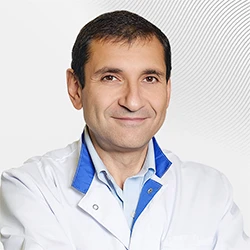Fatty liver disease
There are 2 stages (forms) of the disease - non-alcoholic stethosis and steatohepatitis. The differences determine the prognosis, treatment regimen, frequency of visits to the doctor, and the risk of complications.
In nonalcoholic steatohepatitis (NASH), an inflammatory necrotic process begins in the liver tissue, and the structure of the organ changes. The liver becomes heterogeneous, with patches of cholesterol. An excessive amount of cholesterol can lead to disruption of the entire liver, while a small amount is likely to be harmless.
Causes of fatty liver disease
It is assumed that fatty liver disease is most widespread in Western ("developed") countries. countries due to the lack of scarcity of food resources, and even vice versa, their diversity and accessibility. People with obesity or metabolic syndrome are most susceptible to liver steatosis. With a body mass index of more than 27, there is no doubt that fat cells have settled not only in the subcutaneous tissue, but also in other organs, including the liver. However, for unknown reasons, 7% of patients with normal body weight also show significant fatty liver changes.
Obesity is an "epidemic of the 21st century", one of the most common chronic diseases in the world. Overweight and obesity account for 44% of cases of diabetes, 23% of cases of coronary heart disease, and 7% to 41% of cases of certain cancers.The results of Russian studies have shown that at least 30% of people of working age are overweight and 25% are obese. 75-93% of obese people have some form of non-alcoholic fatty liver disease (NAFLD). With morbid obesity, this figure increases to 95-100%. One reason is that obese patients usually take more medications than non-obese patients, and many drugs are hepatotoxic and can cause liver damage.
One of the common causes of fatty hepatosis is an "unhealthy lifestyle". In the context of liver diseases, high-calorie diets with excessive consumption of fats, refined carbohydrates, fructose, as well as physical inactivity (sedentary lifestyle) are most relevant.
Widespread physical inactivity accompanies life in the city. Many medications have a negative effect on the liver: scientists have proven the negative effects of a number of antibiotics, statins (drugs to lower blood cholesterol), antiviral, antihistamines and diuretics. Hormone replacement therapy can also have an effect on the liver.
Interestingly, some dietary supplements have fallen out of favor – another proof that these "harmless" remedies are not so harmless. And a very unusual fact is the harmful effect of the well–known paracetamol on the liver.
Another possible cause of liver obesity is endocrine diseases. In particular, hypothyroidism. Unfortunately, it is becoming more common today. In most regions of our country, there is an iodine deficiency, which, in fact, leads to thyroid disorders.
The desire of modern women for an ideal body, numerous strict diets are harmful to the whole body, including the liver.
Scientists have also been able to identify several genetic factors:
-
association with the PNPLA gene (I148M allele),
-
association with the TM6SF2 gene (E167K allele).
Carriers of these alleles have a significantly increased amount of fat in the liver.
So, primary non-alcoholic steatohepatitis often occurs in people with excess visceral fat in the body, type 2 diabetes mellitus (DM2) or impaired glucose tolerance, insulin resistance (IR), dyslipidemia. Secondary non-alcoholic steatohepatitis sometimes occurs with starvation (more often protein), rapid weight loss, exposure to a number of medications, malabsorption syndromes and bacterial overgrowth.
Risk factors:
-
age over 45 years;
-
Body Mass Index (BMI) > 28 kg/m2;
-
female gender;
-
arterial hypertension;
-
type 2 diabetes mellitus;
-
increased activity of the enzyme alanine aminotransferase (ALT) by two times or more;
-
The insulin resistance index (NOMA-IR) is more than 5;
-
Thyroglobulin (TG) level is 1.7 mmol/l.
If a person has two or more of these factors, they have an increased risk of liver fibrosis.
Symptoms
Liver obesity often lasts for a long time without complaints, asymptomatic. Changes in the liver are often detected by doctors during routine examinations, especially in people with diabetes, hypertension, and endocrine disorders. At the same time, many people note increased fatigue, weakness, nausea, flatulence, stool disorders, dull pains and heaviness in the right hypochondrium, and an examination reveals an enlarged liver.
Diagnosis of liver obesity
Special attention should be paid to patients at the highest risk:
-
age over 50 years
-
type 2 diabetes mellitus
-
metabolic syndrome
Diagnosis of liver obesity
Special attention in the diagnosis should be given to patients at the highest risk:
-
age over 50 years
-
the presence of type 2 diabetes
-
the presence of metabolic syndrome
Gastroenterologist Anna Kiselyova comments: "Before making a diagnosis of non-alcoholic fatty liver disease, you need to make sure that the patient does not abuse alcohol (generally accepted norms are no more than 30 g per day for men, no more than 20 g per day for women).The first stage of diagnosis is ultrasound, which can detect signs of steatosis, but a deeper examination is needed to determine the stage and prognosis. Calculated indices and the use of serum markers of fibrosis and steatosis have become widespread in Western countries. In Russia, we often use Steatotest as part of Fibromax, liver fibroscanning with CAP function."
External changes in the liver structure can be seen using a number of non-invasive methods, including ultrasound. Most often, this method is used during medical examination. But it only allows us to assume one or another ailment. In order to assess the full picture of what is happening, establish a diagnosis and prescribe treatment, a more complete examination is necessary.
The first is a biochemical blood test. The most important are AST (aspartate aminotransferase) and ALT (alanine aminotransferase). These are liver enzymes that are detected when the cells of this organ, hepatocytes, are destroyed.
Next, a cholesterol test. This substance affects not only blood vessels.It is formed in the liver, so an elevated cholesterol level may indicate that there is something wrong. You also need to determine your blood sugar. Even a slight deviation from the normal amount of glucose is important.
There is a whole range of modern tests that help determine a particular form of liver pathology. FibroMax is one of them. It includes five tests, each of which independently checks each parameter, which is an indicator of liver condition, using mathematical formulas.
-
Liver fibrosis is diagnosed by FibroTest, which also includes ActiTest. The test not only determines the presence of fibrosis, but also its stage (F0, F1, F2, F3, F4) and the degree of the non-inflammatory process (A0, A1, A2, A3) according to the international METAVIR system;
-
Fatty liver dystrophy (steatosis) associated with impaired ALT and GGT levels is determined using SteatoTest, a diagnostic of fatty liver dystrophy (steatosis);
-
Alcoholic steatohepatitis (ASH) in patients who abuse alcohol, AshTest shows;
-
Nonalcoholic steatohepatitis (NASH) in overweight people, diabetics, insulin resistance or hyperlipidemia is determined using a non-test (NashTest).
FibroTest, steattest and non-test are used to diagnose non-alcoholic liver obesity.
Puncture biopsy of the liver is the "Gold standard" for diagnosing fatty hepatosis and determining the stage of this disease. During a biopsy, pieces of organ tissue are examined using a microscope. This is the most accurate method to find out what condition the liver is actually in. A biopsy is performed only in a hospital and under local anesthesia. With ultrasound and MRI, it is possible to diagnose NAFLD, but the severity of the disease cannot be predicted.
Treatment of liver obesity
The basis for the development of NAFLD is an unhealthy lifestyle, so it is advisable to start treatment with its correction.:
-
weight loss (a diet with a limited energy value, the exclusion of canned foods, drinks rich in fructose). The Mediterranean approach to nutrition proved to be the most effective.
-
gradual increase in cardio/strength training.
Complete starvation is highly undesirable, because rapid weight loss (0.5 - 1 kg / week) leads to deterioration of the liver. It is recommended to combine a balanced diet, limit the amount of fats and carbohydrates consumed (but not eliminate them completely). Physical activity adequate to the patient's condition is also important. In addition, complete abstinence from alcohol consumption is extremely important.
Medications are prescribed with an obvious progression of the disease and if the patient has a diagnosis of non-alcoholic steatohepatitis, confirmed by a histological examination.
Research into the search for medicines for the treatment of steatohepatitis is still actively underway, and several "promising" drugs can be identified, long-term use of which can significantly improve the condition of the liver. Such drugs include metformin, pioglitazone (used less frequently), vitamin E, liraglutide, omega 3 .
In cases where ongoing therapeutic measures (diet, sports, medications) do not have the desired effect, bariatric surgery can be resorted to, the effect of which is most noticeable in the short term and quite stable in the future.
Treatment of liver obesity is a rather lengthy process. But by starting treatment at the earliest possible stage, serious side effects and complications can be avoided. Therefore, do not delay the visit to the doctor.
Consequences in the absence of treatment
-
Cirrhosis of the liver, which can be caused not only by alcohol and viral causes, but also by hepatosis.
-
Long-term fatty liver disease can cause a violation of carbohydrate metabolism. In this case, we are already talking about the "metabolic syndrome", the main criteria of which are abdominal obesity, hypertension, elevated blood sugar and cholesterol levels, which significantly increases the risk of developing cardiovascular diseases, type 2 diabetes and many other diseases.
Prevention
Is there a way to protect yourself from developing fatty liver?
Absolutely! the basis of prevention is a healthy lifestyle. The sooner you reconsider your eating habits, start exercising, and avoid taking various "wellness" supplements, the more likely you will be able to avoid developing hepatosis and its dangerous complications.
EMC specialists are ready to help you develop an individual nutrition and physical activity plan.Based on the data from a comprehensive examination (including genetic testing), a team of specialists consisting of a nutritionist, cardiologist, hepatologist, endocrinologist, and physiotherapist will draw up an individual healthy eating plan for you and an adequate workload (taking into account your physical fitness, work activity, and preferences). This approach allows our patients to avoid developing a large number of chronic diseases in the future and significantly improve their quality of life.
References
-
Komshilova K.A., Troshina E.A., Butrova S.A. Non-alcoholic fatty liver disease in obesity//Obesity and Metabolism, 2011, 3, pp. 3-11.
-
Demidova T.Yu., Kruglova E.L. Obesity as a key and modifiable cause of type 2 diabetes mellitus // Breast cancer, 2009, 7, pp. 450-454.
-
Stuart B, Lloyd J, Zhao L, Kamal-Bahl S. Obesity, disease burden, and prescription spending by community-dwelling Medicare beneficiaries. Curr Med Res Opin 2008;24:2377–2387.
-
Polunina T.E., Maev I.V. Medicinal liver damage// Consilium medicum, Gastroenterology, 2011, 2, p. 54.
-
Porceddu M, Buron N, Roussel C, Labbe G, Fromenty B, Borgne-Sanchez A. Prediction of liver injury induced by chemicals in human with a multiparametric assay on isolated mouse liver mitochondria. Toxicol Sci 2012;129:332–345.
-
Begriche K, Massart J, Robin MA, Borgne-Sanchez A, Fromenty B. Druginduced toxicity on mitochondria and lipid metabolism: mechanistic persity and deleterious consequences for the liver. J Hepatol 2011;54:773–794.
-
Kosobyan E.P., Smirnova O.M. Modern concepts of the pathogenesis of non-alcoholic fatty liver disease. Diabetes mellitus, 2010, 1, pp. 55-64.
-
Dixon J.B., Bhathal P.S., O’Brien P.E. Nonalcoholic fatty liver disease: predictors of nonalcoholic steatohepatitis and liver fibrosis in the severely obese. Gastroenterology, 2001, 121, pp. 91-100.
-
James O.F.W., Leuschner U., Dancygier H. Diagnosis of non-alcoholic steatohepatitis. Steatohepatitis. Dordrecht: Kluwer Academic Publishers, 2001, pp. 34-39.
-
Munteanu et al. Noninvasive biomarkers for the screening of fibrosis, steatosis and steatohepatitis in patients with metabolic risk factors: FibroTest-FibroMax Experience. J Gastrointestin Liver Dis., 2008, 17, pp.187-191.
-
Poynard T. and al. Meta-analyses of Fibro Test diagnostic value in chronic liver disease. BMC Gastroenterology, 2007, 7, p. 40.
Why the EMC
The first and only clinic in Russia, created in the image of the world's leading clinics
EMC is a multidisciplinary center offering patients a high level of medical services and a personalized approach
Worldwide recognition and awards
 Learn more
Learn more
Worldwide recognition and awards
 Certificates and licenses
Certificates and licenses
Make an appointment for a consultation
Specify your contacts and we will contact you to clarify the details
Reviews
and new products of the EMC



.webp)



.webp)


.webp)

.webp)


.webp)
.webp)

.webp)

